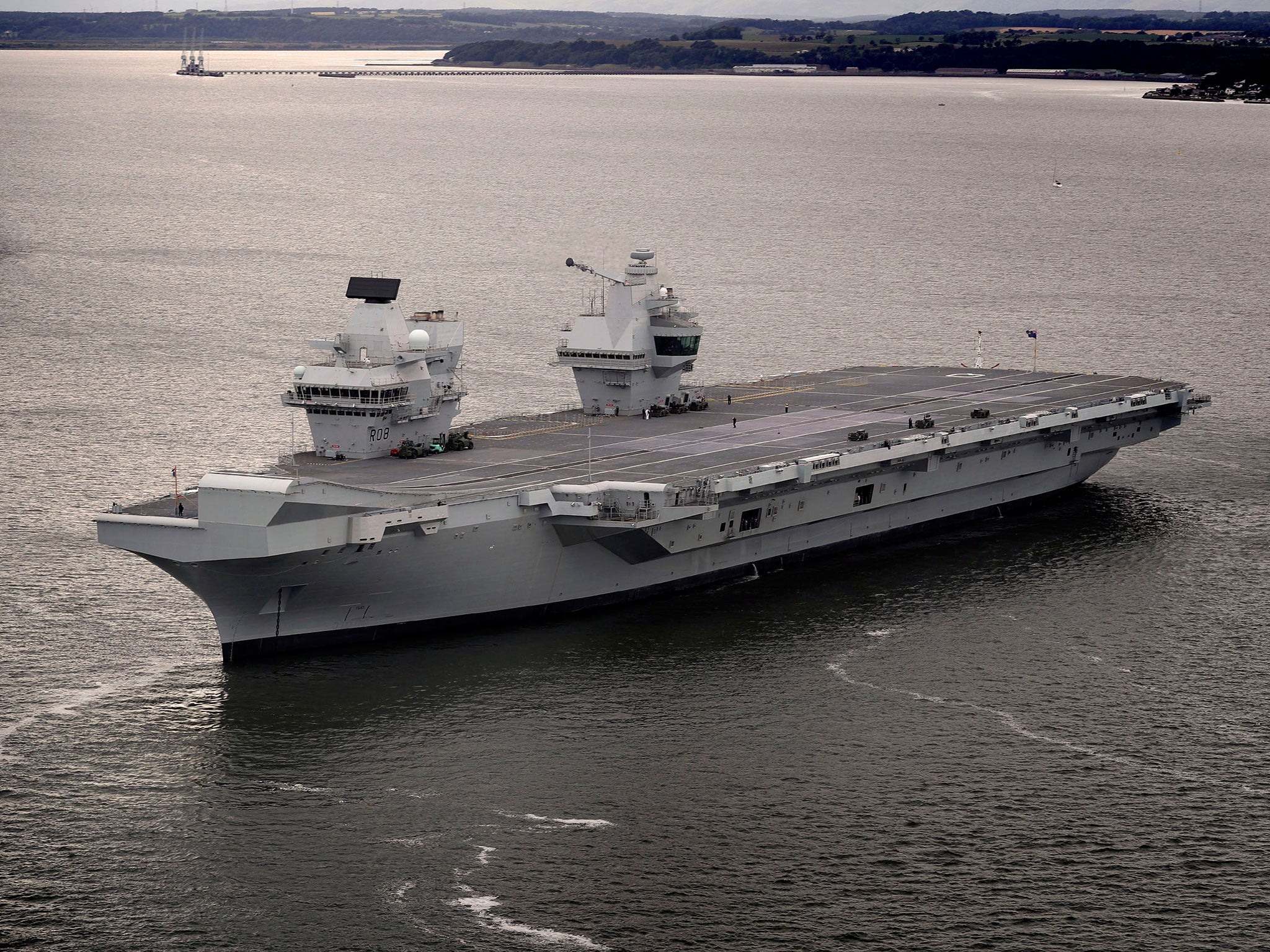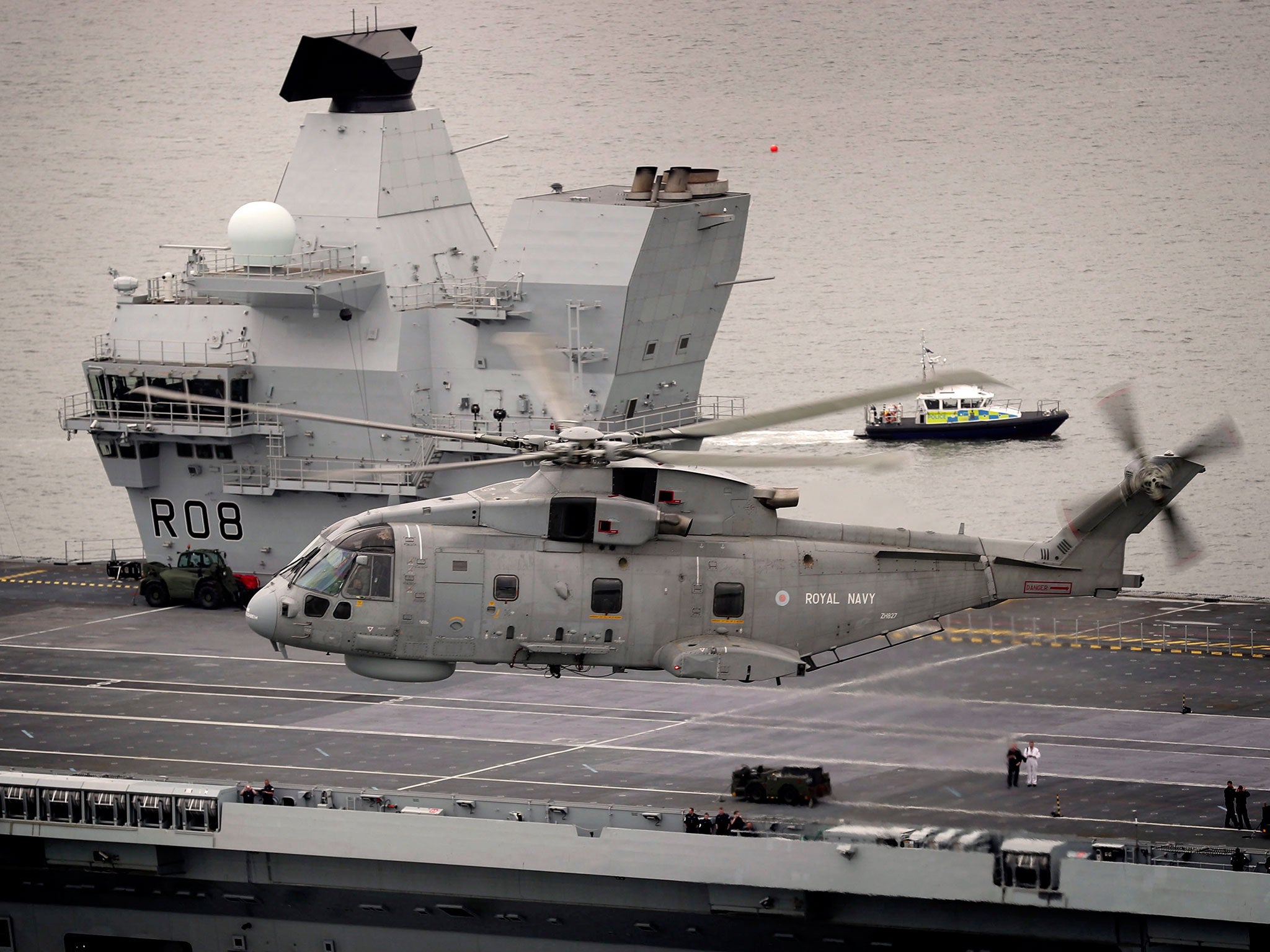UK's most expensive military assets 'increasingly vulnerable' to cheap missile attacks by Russia and China
RUSI report finds attack could 'at least disable' new British aircraft carrier costing over £3bn

Your support helps us to tell the story
From reproductive rights to climate change to Big Tech, The Independent is on the ground when the story is developing. Whether it's investigating the financials of Elon Musk's pro-Trump PAC or producing our latest documentary, 'The A Word', which shines a light on the American women fighting for reproductive rights, we know how important it is to parse out the facts from the messaging.
At such a critical moment in US history, we need reporters on the ground. Your donation allows us to keep sending journalists to speak to both sides of the story.
The Independent is trusted by Americans across the entire political spectrum. And unlike many other quality news outlets, we choose not to lock Americans out of our reporting and analysis with paywalls. We believe quality journalism should be available to everyone, paid for by those who can afford it.
Your support makes all the difference.British military assets including the new HMS Queen Elizabeth aircraft carrier are increasingly vulnerable to cheap missile attacks from Russia and China, warns a new report calling for a dramatic re-think on defence.
The Royal United Services Institute (RUSI) identified a series of complex threats to ships, military aircraft and conventional weapons by states including North Korea and terror groups.
Authors said that although potential adversaries have not “caught up” with the US and UK in all areas, they have focused efforts on low-cost and high-threat areas including precision missiles and cyber attacks to increase the threat.
“UK defence equipment capabilities costing £16bn a year are increasingly vulnerable to low-cost, technology-rich weapons from hostile states,” the RUSI report concluded.
“The advancing capabilities of potential adversaries of the UK should be a genuine concern.
“Russia and China have developed the surveillance and precision strike capabilities to put at serious risk Western surface ships, large military aircraft and arguably any land system, even the most heavily armoured.”
Authors said that Russia is extending its range of missiles, while China claims to have developed a J-20 stealth fighter jet and Iran says it possesses its own supersonic, ballistic anti-ship missile.
“The UK’s potential adversaries have also focused on developing relatively inexpensive weapons that can disable or destroy expensive assets,” the report continued.
Western governments have been made “acutely aware” of the financial imbalance while battling Isis, which has been manufacturing its own armoured vehicles, explosives, mines, missiles and drones in Syria and Iraq.
An American official told RUSI that the US-led coalition has found itself using weapons costing $70,000 (£54,000), sometimes fired from aircraft that cost $30,000 (£23,000) an hour to fly, to destroy just one of the countless Toyota pick-up trucks used by Isis.
RUSI’s report found a similar gulf exists with hostile states, saying: “Missiles costing [much] less than half a million pounds a unit could at least disable a British aircraft carrier that costs more than £3bn.
“Indeed, a salvo of ten such missiles would cost less than $5m (£4m)…China and Russia appear to have focused many (but not all) their efforts on being able to put at risk the key Western assets that are large, few in number and expensive.”
The report cautioned that it has become much cheaper to destroy major systems than to develop them, “making large-scale attacks on a single target more likely”.
It did not specifically name the two new Queen Elizabeth Class aircraft carriers being developed for the Royal Navy, but Russian state media enthusiastically seized on its findings.

The HMS Queen Elizabeth – the largest British warship ever built - is due to enter service this year after tests currently underway in Scotland and will be followed by the HMS Prince of Wales.
Described as an “icon” by the Royal Navy, the Defence Secretary recently used the HMS Queen Elizabeth to taunt Russia over the “dilapidated” aircraft carrier it sent to bomb Syria last year.
“When you saw that old, dilapidated Kuznetsov sailing through the Channel, a few months ago, I think the Russians will look at this ship with a little bit of envy,” he wrote of Russia’s only aircraft carrier last month.
“It's really routine for the Russians to collect intelligence on our ships. We will take every precaution to make sure that they don't get too close, but I think they will be admiring [the HMS Queen Elizabeth].”
Following RUSI’s report, the Russian defence ministry described the ship as “merely a large convenient naval target”.
“It is in the interests of the British Royal Navy not to show off the ‘beauty’ of its aircraft carrier on the high seas any closer than a few hundred miles from its Russian ‘distant relative,’” said a statement to state-funded broadcaster Russia Today.
A spokesperson for the Ministry of Defence (MoD) said it was keeping all threats under constant review, adding: “We are confident our new aircraft carrier, and other state-of-the-art equipment, is well protected thanks to defensive systems we have invested in as part of our £178bn equipment plan.
“Our carrier strike group will be able to operate around the globe allowing Britain to pro-actively meet future threats and support operations in a range of theatres. It will be robustly protected by air and sea assets against threats known and unknown.”
Following an American view of the US’ military capability that stressed the need for technological change, the MoD launched its own Defence Innovation Initiative in September last year.
It has committed £800m over a decade for research, as well as maintaining 1.2 per cent of the defence budget for science and technology.
RUSI’s report argued that the British Government should shift its focus from attack systems to research, innovation and “adaptive technologies”.
It warned of the crowing threat of cyber attacks and threats to the West’s use of satellites in space, with China conducting a test destruction of a satellite in 2009 and Russia reportedly seeking an airborne laser weapon.
Enemies could take out communications and navigation systems for Western militaries, the report said, or target the UK’s economy and crucial IT infrastructure causing chaos far beyond that seen in the NHS during the WannaCry ransomware attack.

It listed risks as Russia, China, North Korea, migration, terrorism, low economic growth including the uncertainty caused by Brexit, rapid change and unforeseen conflicts.
RUSI found that the UK and its allies must “rethink” deterrence, calling Nato’s readiness to explicitly consider nuclear options as a response to conventional attacks “a hangover from the Cold War that looks less appropriate and credible” than ever.
Lord Arbuthnot, a former defence minister and ex-chairman of the House of Commons Defence Select Committee, said the UK must remain “relevant, flexible and adaptable” to stay safe.
“The world now is more complex, interdependent and downright dangerous than I can ever remember,” he wrote in the report.
“Biomedicine, artificial intelligence, the internet of things and quantum computing are changing our lives in ways we can only just begin to imagine.
“It would be naive to assume that they will not change our constructs of defence and notions of the secure society.”
Join our commenting forum
Join thought-provoking conversations, follow other Independent readers and see their replies
Comments